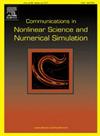利用改进的标量辅助变量(iSAV)方法求解各向异性相场晶体模型的高效、精确的数值格式
IF 3.4
2区 数学
Q1 MATHEMATICS, APPLIED
Communications in Nonlinear Science and Numerical Simulation
Pub Date : 2025-04-24
DOI:10.1016/j.cnsns.2025.108875
引用次数: 0
摘要
二维各向异性相场晶体(APFC)模型是一个六阶非线性抛物方程,可以用来模拟各种现象,如外延生长、材料硬度和相变。标量辅助变量法(SAV)是求解各种非线性耗散系统的常用方法,改进后的SAV法(iSAV)不仅是完全线性的,而且严格保证了原耗散规律。本文基于iSAV方法,构造了几种高效、精确的APFC模型的线性原始能量稳定数值格式。首先,考虑一阶iSAV方案来保持APFC模型的原始能量稳定性。其次,提出了一种新的稳定iSAV方案,并对其进行了严格的能量稳定性分析,以保持其原有的耗散规律。最后,给出了几个有趣的数值算例来验证所提方法的准确性和有效性。本文章由计算机程序翻译,如有差异,请以英文原文为准。
Highly efficient and accurate numerical schemes for the anisotropic phase field crystal models by using the improved scalar auxiliary variable (iSAV) approach
The two-dimensional anisotropic phase field crystal (APFC) model is a sixth-order nonlinear parabolic equation that can be used to simulate various phenomena such as epitaxial growth, material hardness, and phase transition. The scalar auxiliary variable method (SAV) is a common method to solve various nonlinear dissipative systems, and the improved SAV (iSAV) method is not only completely linear, but also strictly guarantees the original dissipation law. In this paper, we construct several efficient, accurate linear and original energy-stable numerical schemes of the APFC model based on the iSAV method. Firstly, a first-order iSAV scheme is considered to keep the original energy stability for the APFC model. Secondly, we propose a new stabilized iSAV scheme and give its rigorous energy stability analysis to keep its original dissipation law. Finally, several interesting numerical examples are presented to demonstrate the accuracy and effectiveness of the proposed methods.
求助全文
通过发布文献求助,成功后即可免费获取论文全文。
去求助
来源期刊

Communications in Nonlinear Science and Numerical Simulation
MATHEMATICS, APPLIED-MATHEMATICS, INTERDISCIPLINARY APPLICATIONS
CiteScore
6.80
自引率
7.70%
发文量
378
审稿时长
78 days
期刊介绍:
The journal publishes original research findings on experimental observation, mathematical modeling, theoretical analysis and numerical simulation, for more accurate description, better prediction or novel application, of nonlinear phenomena in science and engineering. It offers a venue for researchers to make rapid exchange of ideas and techniques in nonlinear science and complexity.
The submission of manuscripts with cross-disciplinary approaches in nonlinear science and complexity is particularly encouraged.
Topics of interest:
Nonlinear differential or delay equations, Lie group analysis and asymptotic methods, Discontinuous systems, Fractals, Fractional calculus and dynamics, Nonlinear effects in quantum mechanics, Nonlinear stochastic processes, Experimental nonlinear science, Time-series and signal analysis, Computational methods and simulations in nonlinear science and engineering, Control of dynamical systems, Synchronization, Lyapunov analysis, High-dimensional chaos and turbulence, Chaos in Hamiltonian systems, Integrable systems and solitons, Collective behavior in many-body systems, Biological physics and networks, Nonlinear mechanical systems, Complex systems and complexity.
No length limitation for contributions is set, but only concisely written manuscripts are published. Brief papers are published on the basis of Rapid Communications. Discussions of previously published papers are welcome.
 求助内容:
求助内容: 应助结果提醒方式:
应助结果提醒方式:


